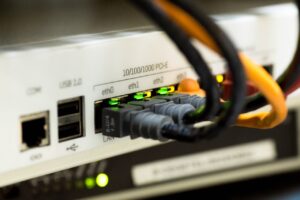Staying connected is something we all struggle with regardless of whether we’re working from home, the office, or on the go. When you are at your most busy is when you need your internet connection to be performing at its best. This post will help you get the most out of your internet connection, router, and other gear.
Check Your Equipment
No matter what your internet service provider (ISP) advertises, if you’re using outdated or poorly maintained equipment, then chances are your WIFI connection will suffer under even the most ideal circumstances. The first thing you want to do and something you’ll want to continue to do every so often going forward is to check the state of your equipment.
This means the router, the modem if it’s separate, the type of cable connecting to your hardwired devices, the type of lines run to bring the service into your home or office, and any auxiliary equipment, signal boosters, etc.
Even a router that is a few years old will perform poorly by today’s standards. Make sure your equipment is as up-to-date as possible. Run new lines if you notice they are getting frayed or stretched and invest in signal boosters or a mesh network if you have a very large home or office complex.
Run Speed Tests Frequently
We can’t stress this enough, test, test again, and retest your internet connection speed.
Just because you get good speed in the morning doesn’t mean you’ll get the same during peak usage hours. Remember that speed estimates are just that. Frequently testing your speed will do two things.
One, it will identify times of day when speed is slowed due to high traffic. Two, it will help identify problems with your connection. In some cases, you may find that you have a lot of background programs running from multiple devices that are causing you to lag while doing important work. Other times, it may be that the network is simply busy. Finding and eliminating the problems that you can manage will help maintain optimal speed.
Find the Optimal Location For Your Router
This last tip seems obvious, but many people forget when setting up their network. Routers perform better under certain conditions.
Firstly, the single is broadcast in a downward fashion, so the higher up the router the better the signal transmits to the devices below it.
Second, the better and more stable the connection to the source is, the better it performs overall. By this we mean, you shouldn’t be running your coaxial cable 50 feet across a lobby, under a rug, and up the wall to reach your router. The shorter the distance, the less speed lost.
Lastly, routers only have a certain range. If your home is very large you may have to invest in boosters, buy a separate router for different floors and have a second line. Finding the optimal position in your home or office that is centrally located and away from obstructions like concrete walls and other barriers will help improve your signal throughout the space.
Final Thoughts
These were just a few tips to help you get more out of your internet connection so that you can stay connected when it matters most. Staying on top of your equipment and finding the right way to use it will help you avoid nasty slowdowns and business interrupting service problems.





